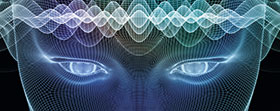

Napoleon Hill said: “Whatever the mind can conceive and believe, it can achieve.” This little gem has no doubt contributed to the development of many allegedly inconceivable achievements. Often, things we read about are relegated to the realm of science fiction, simply too incredible to be true. Using software to emulate the functions of the brain in the recognition of faces is a case in point.
The very idea of a computer being able to recognise people in a similar way to which we as humans instinctively recognise individuals, is mind boggling.

Andrè Immelman, CEO of eyeThenticate Technology Labs, says that in the KYC (know your customer/client) realm, the question is whether you know if the person to whom you are speaking is actually the person who they say they are. Trusting their word is simply not enough, so people have tended to rely on the credentials that they expect the person to present in the form of their passport, ID book or access token. These elements, he says, are not really trustworthy in reality. Traditionally, people have also relied on passwords and pin codes for authentication, but unfortunately these can be intercepted and compromised.
Upping the ante, it has become customary to rely on who the person is through a biological, physiological or psychological trait that defines them. Typically, fingerprints were used as a means of identification, but this has led to what is commonly known as ‘CSI Effect/Syndrome’ which is any of several ways in which the exaggerated portrayal of forensic science on crime television shows such as CSI (Crime Scene Investigation) influences public perception. In this scenario, the fingerprint is deemed proof positive of who the person is.
This is, however, erroneous since fingerprints can be duplicated and in recent cases it was found that fingerprints are not actually unique. Two of these cases are Brandon Mayfield, who in 2004 was wrongly linked to the Madrid train bombings by FBI fingerprint experts in the United States; and Shirley McKie, a Scottish police officer, who was wrongly accused of having been at a murder scene in 1997 after a print supposedly matching hers was found near the body. (Source: http://www.telegraph.co.uk/science/2016/03/14/why-your-fingerprints-may-not-be-unique/))
Immelman says that fingerprints are therefore not as foolproof as we have assumed in the past. He adds that to measure fingerprints properly, one needs to employ sophisticated and expensive technology to obtain a reasonable degree of accuracy. Based on the matching of a specific number of dots extracted from the fingerprint, the success rate, especially on latent fingerprints, is minimal. The same is true of points of comparison on a face. These methods of identification are, in his opinion, highly unreliable.

I know you
Immelman explains that if one thinks of a family member, then it is more or less a given that you would be able to identify them out of hundreds of other people in a crowd. This recognition is very different to the mathematical algorithms used to match a fingerprint or face (in facial recognition technology). There is something in our natural makeup which is far more sophisticated than these algorithms.
Researchers at the University of Johannesburg started an initiative, in collaboration with eyeThenticate Technology Labs, which has resulted in a better understanding of what the human brain does to recognise individuals. The technology they have developed is able to mimic brain function to simulate human cognition. Leveraging the workings of the neural network, artificial intelligence and other technologies means that the team is now able to harness this capability by taking an image of the person and mimicking human brain recognition.
The question they posed is ‘What processes do the brain neurons perform to recognise somebody?’ Although the team is still perfecting the science behind this concept, the resultant solution is, in Immelman’s opinion, far superior to anything else on the market and it is continuously evolving.
In a nutshell, the person authenticating another person’s identity (for example a police officer apprehending a suspect) would, using their own smartphone, simply take a photograph of the person in question. The image is then automatically synced to eyeThenticate’s servers via the cloud, using an app installed on the mobile device. The servers compare the processed image with images found on the very large database. Results are available in mere seconds and these results will either provide verification and authentication of the person’s identity or will identify them as an imposter.
Immelman says that the technology can be used in a number of applications including law enforcement, border control, security agencies and for financial services. “We finally have a solution that will arrest identity theft. The technology gives one the profound ability to accurately verify the true identity of a person. In pilot tests, the technology demonstrated near perfect results for a group of more than one million individuals.”
| Tel: | +27 11 543 5800 |
| Email: | [email protected] |
| www: | www.technews.co.za |
| Articles: | More information and articles about Technews Publishing |

© Technews Publishing (Pty) Ltd. | All Rights Reserved.